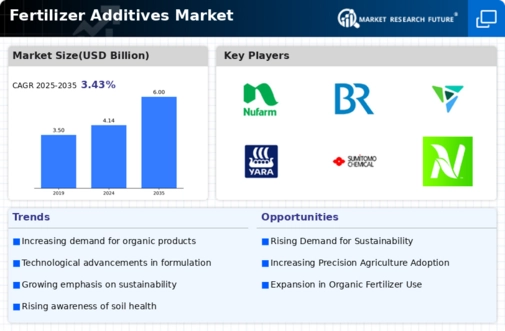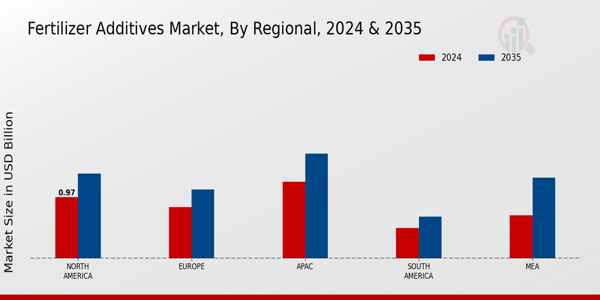-
MARKET INTRODUCTION
-
Definition
-
Scope
- Research Objective
- Assumption
- Limitations
-
RESEARCH METHODOLOGY
-
Overview
-
Data
-
Secondary Research
-
Primary Research
-
Forecasting
-
Market Size Estimation
- Bottom-Up Approach
-
Data Triangulation
-
Validation
-
MARKET
-
Overview
-
Drivers
-
Restraints
-
Opportunities
-
MARKET FACTOR ANALYSIS
-
Porter's Five Forces Analysis
- Bargaining Power of Suppliers
- Bargaining Power of Buyers
- Threat of New Entrants
- Intensity of Rivalry
-
COVID-19 Impact Analysis
- Regional Impact
- Opportunity and Threat Analysis
-
Stabilizers
-
Coating Agents
-
Enhancers
-
FERTILIZER ADDITIVES MARKET, BY APPLICATION
-
Cereals and Grains
-
Fruits and Vegetables
-
Non-Crop
-
FERTILIZER ADDITIVES MARKET, BY FORMULATION TYPE (USD BILLION)
-
Granular
-
Water Soluble
-
Slow Release
-
FERTILIZER
-
Soil Health Improvement
-
Reduced Leaching
-
Enhanced Crop Yield
- US
- Canada
-
Europe
- Germany
- France
- Italy
- Spain
-
APAC
- China
- Japan
- South Korea
- Thailand
- Indonesia
-
South America
- Brazil
- Argentina
- Rest of South America
- GCC Countries
- South Africa
-
COMPETITIVE LANDSCAPE
-
Overview
-
Competitive
-
Market share Analysis
-
Major Growth Strategy in the Fertilizer Additives Market
-
Competitive Benchmarking
-
Leading Players in Terms of Number of Developments in
-
Key
-
Major Players Financial
- Sales and Operating Income
- Major Players R&D Expenditure.
-
COMPANY PROFILES
-
FMC Corporation
- Products Offered
- Key Developments
- Key Strategies
-
Solvay
- Products Offered
- Key Developments
- Key Strategies
-
WilburEllis
- Products Offered
- Key Developments
- Key Strategies
-
UPL Limited
- Products Offered
- Key Developments
- Key Strategies
-
Yara International
- Products Offered
- Key Developments
- Key Strategies
-
Nutrien
- Products Offered
- Key Developments
- Key Strategies
-
Adama Agricultural Solutions
- Products Offered
- Key Developments
- Key Strategies
-
The Mosaic Company
- Products Offered
- Key Developments
- Key Strategies
-
Haifa Group
- Products Offered
- Key Developments
- Key Strategies
-
Nufarm
- Products Offered
- Key Developments
- Key Strategies
-
Origin Enterprises
- Products Offered
- Key Developments
- Key Strategies
-
Valagro
- Products Offered
- Key Developments
- Key Strategies
-
BASF
- Products Offered
- Key Developments
- Key Strategies
-
CF Industries
- Products Offered
- Key Developments
- Key Strategies
-
K+S Aktiengesellschaft
- Products Offered
- Key Developments
- Key Strategies
-
APPENDIX
-
References
-
Related Reports
-
NORTH AMERICA FERTILIZER
-
NORTH AMERICA FERTILIZER
-
NORTH AMERICA FERTILIZER ADDITIVES
-
NORTH AMERICA FERTILIZER ADDITIVES
-
NORTH AMERICA FERTILIZER ADDITIVES
-
US FERTILIZER ADDITIVES MARKET SIZE ESTIMATES &
-
US FERTILIZER ADDITIVES MARKET SIZE ESTIMATES & FORECAST, BY APPLICATION,
-
CANADA FERTILIZER ADDITIVES
-
CANADA FERTILIZER ADDITIVES
-
CANADA FERTILIZER ADDITIVES MARKET SIZE ESTIMATES
-
CANADA FERTILIZER ADDITIVES MARKET SIZE ESTIMATES
-
CANADA FERTILIZER ADDITIVES MARKET SIZE ESTIMATES & FORECAST, BY REGIONAL,
-
GERMANY FERTILIZER
-
GERMANY FERTILIZER
-
GERMANY FERTILIZER ADDITIVES
-
GERMANY FERTILIZER ADDITIVES
-
GERMANY FERTILIZER ADDITIVES
-
UK FERTILIZER ADDITIVES MARKET SIZE ESTIMATES &
-
UK FERTILIZER ADDITIVES MARKET SIZE ESTIMATES & FORECAST, BY APPLICATION,
-
FRANCE FERTILIZER ADDITIVES
-
FRANCE FERTILIZER ADDITIVES
-
FRANCE FERTILIZER ADDITIVES MARKET SIZE ESTIMATES
-
FRANCE FERTILIZER ADDITIVES MARKET SIZE ESTIMATES
-
FRANCE FERTILIZER ADDITIVES MARKET SIZE ESTIMATES & FORECAST, BY REGIONAL,
-
ITALY FERTILIZER ADDITIVES
-
ITALY FERTILIZER ADDITIVES
-
ITALY FERTILIZER ADDITIVES MARKET SIZE ESTIMATES
-
ITALY FERTILIZER ADDITIVES MARKET SIZE ESTIMATES
-
ITALY FERTILIZER ADDITIVES MARKET SIZE ESTIMATES & FORECAST, BY REGIONAL,
-
REST OF EUROPE FERTILIZER
-
REST OF EUROPE FERTILIZER
-
REST OF EUROPE FERTILIZER
-
REST OF EUROPE FERTILIZER
-
REST OF EUROPE FERTILIZER
-
APAC FERTILIZER ADDITIVES
-
APAC FERTILIZER ADDITIVES
-
APAC FERTILIZER ADDITIVES MARKET SIZE ESTIMATES &
-
APAC FERTILIZER ADDITIVES MARKET SIZE ESTIMATES & FORECAST, BY FUNCTIONALITY,
-
CHINA FERTILIZER ADDITIVES
-
CHINA FERTILIZER ADDITIVES
-
CHINA FERTILIZER ADDITIVES MARKET SIZE ESTIMATES
-
CHINA FERTILIZER ADDITIVES MARKET SIZE ESTIMATES
-
CHINA FERTILIZER ADDITIVES MARKET SIZE ESTIMATES & FORECAST, BY REGIONAL,
-
JAPAN FERTILIZER ADDITIVES
-
JAPAN FERTILIZER ADDITIVES
-
JAPAN FERTILIZER ADDITIVES MARKET SIZE ESTIMATES
-
JAPAN FERTILIZER ADDITIVES MARKET SIZE ESTIMATES
-
JAPAN FERTILIZER ADDITIVES MARKET SIZE ESTIMATES & FORECAST, BY REGIONAL,
-
MEXICO FERTILIZER
-
MEXICO FERTILIZER
-
MEXICO FERTILIZER ADDITIVES
-
MEXICO FERTILIZER ADDITIVES
-
MEXICO FERTILIZER ADDITIVES
-
ARGENTINA FERTILIZER ADDITIVES MARKET SIZE ESTIMATES
-
ARGENTINA FERTILIZER ADDITIVES MARKET SIZE ESTIMATES & FORECAST, BY APPLICATION,
-
REST OF SOUTH AMERICA FERTILIZER ADDITIVES MARKET SIZE ESTIMATES & FORECAST,
-
REST OF SOUTH AMERICA FERTILIZER ADDITIVES MARKET SIZE ESTIMATES & FORECAST,
-
REST OF SOUTH AMERICA FERTILIZER ADDITIVES MARKET SIZE ESTIMATES & FORECAST,
-
MEA FERTILIZER ADDITIVES
-
MEA FERTILIZER ADDITIVES
-
MEA FERTILIZER ADDITIVES
-
GCC COUNTRIES FERTILIZER ADDITIVES MARKET SIZE ESTIMATES
-
GCC COUNTRIES FERTILIZER ADDITIVES MARKET SIZE ESTIMATES & FORECAST, BY
-
ACQUISITION/PARTNERSHIP
-
MARKET SYNOPSIS
-
NORTH AMERICA FERTILIZER ADDITIVES MARKET ANALYSIS
-
US FERTILIZER ADDITIVES MARKET
-
US FERTILIZER ADDITIVES MARKET ANALYSIS BY FORMULATION TYPE
-
US FERTILIZER ADDITIVES MARKET ANALYSIS BY FUNCTIONALITY
-
US FERTILIZER ADDITIVES MARKET
-
CANADA FERTILIZER ADDITIVES
-
CANADA FERTILIZER ADDITIVES MARKET ANALYSIS BY FORMULATION TYPE
-
CANADA FERTILIZER ADDITIVES MARKET ANALYSIS BY FUNCTIONALITY
-
CANADA FERTILIZER ADDITIVES
-
GERMANY FERTILIZER ADDITIVES MARKET ANALYSIS BY ADDITIVE TYPE
-
GERMANY FERTILIZER ADDITIVES MARKET ANALYSIS BY
-
GERMANY FERTILIZER
-
GERMANY FERTILIZER ADDITIVES MARKET ANALYSIS BY FUNCTIONALITY
-
GERMANY FERTILIZER ADDITIVES MARKET ANALYSIS BY
-
UK FERTILIZER ADDITIVES
-
UK FERTILIZER ADDITIVES MARKET ANALYSIS BY FORMULATION TYPE
-
UK FERTILIZER ADDITIVES MARKET ANALYSIS BY FUNCTIONALITY
-
UK FERTILIZER ADDITIVES MARKET
-
FRANCE FERTILIZER
-
FRANCE FERTILIZER ADDITIVES MARKET ANALYSIS BY APPLICATION
-
FRANCE FERTILIZER ADDITIVES MARKET ANALYSIS BY FORMULATION
-
FRANCE FERTILIZER
-
FRANCE FERTILIZER ADDITIVES MARKET ANALYSIS BY REGIONAL
-
RUSSIA FERTILIZER ADDITIVES MARKET ANALYSIS BY ADDITIVE TYPE
-
RUSSIA FERTILIZER ADDITIVES MARKET ANALYSIS BY APPLICATION
-
RUSSIA FERTILIZER ADDITIVES
-
RUSSIA FERTILIZER ADDITIVES MARKET ANALYSIS BY REGIONAL
-
ITALY FERTILIZER ADDITIVES MARKET ANALYSIS BY ADDITIVE TYPE
-
ITALY FERTILIZER ADDITIVES MARKET ANALYSIS BY APPLICATION
-
ITALY FERTILIZER ADDITIVES
-
ITALY FERTILIZER ADDITIVES MARKET ANALYSIS BY REGIONAL
-
SPAIN FERTILIZER ADDITIVES MARKET ANALYSIS BY ADDITIVE TYPE
-
SPAIN FERTILIZER ADDITIVES MARKET ANALYSIS BY APPLICATION
-
SPAIN FERTILIZER ADDITIVES
-
SPAIN FERTILIZER ADDITIVES MARKET ANALYSIS BY REGIONAL
-
REST OF EUROPE FERTILIZER ADDITIVES MARKET ANALYSIS BY ADDITIVE TYPE
-
REST OF EUROPE FERTILIZER ADDITIVES MARKET ANALYSIS
-
REST OF EUROPE FERTILIZER
-
REST OF EUROPE FERTILIZER ADDITIVES MARKET ANALYSIS BY FUNCTIONALITY
-
REST OF EUROPE FERTILIZER ADDITIVES MARKET ANALYSIS
-
APAC FERTILIZER ADDITIVES
-
CHINA FERTILIZER ADDITIVES
-
CHINA FERTILIZER ADDITIVES MARKET ANALYSIS BY FORMULATION TYPE
-
CHINA FERTILIZER ADDITIVES MARKET ANALYSIS BY FUNCTIONALITY
-
CHINA FERTILIZER ADDITIVES
-
INDIA FERTILIZER ADDITIVES MARKET ANALYSIS BY APPLICATION
-
INDIA FERTILIZER ADDITIVES MARKET ANALYSIS BY FORMULATION
-
INDIA FERTILIZER ADDITIVES
-
JAPAN FERTILIZER ADDITIVES MARKET ANALYSIS BY ADDITIVE TYPE
-
JAPAN FERTILIZER ADDITIVES MARKET ANALYSIS BY APPLICATION
-
JAPAN FERTILIZER ADDITIVES
-
JAPAN FERTILIZER ADDITIVES MARKET ANALYSIS BY REGIONAL
-
SOUTH KOREA FERTILIZER ADDITIVES MARKET ANALYSIS BY ADDITIVE TYPE
-
SOUTH KOREA FERTILIZER ADDITIVES MARKET ANALYSIS
-
SOUTH KOREA FERTILIZER
-
SOUTH KOREA FERTILIZER ADDITIVES MARKET ANALYSIS BY FUNCTIONALITY
-
SOUTH KOREA FERTILIZER ADDITIVES MARKET ANALYSIS
-
MALAYSIA FERTILIZER
-
MALAYSIA FERTILIZER ADDITIVES MARKET ANALYSIS BY APPLICATION
-
MALAYSIA FERTILIZER ADDITIVES MARKET ANALYSIS BY
-
MALAYSIA FERTILIZER
-
MALAYSIA FERTILIZER ADDITIVES MARKET ANALYSIS BY REGIONAL
-
THAILAND FERTILIZER ADDITIVES MARKET ANALYSIS BY
-
THAILAND FERTILIZER
-
THAILAND FERTILIZER ADDITIVES MARKET ANALYSIS BY
-
THAILAND FERTILIZER
-
INDONESIA FERTILIZER ADDITIVES MARKET ANALYSIS BY
-
INDONESIA FERTILIZER
-
INDONESIA FERTILIZER ADDITIVES MARKET ANALYSIS BY FUNCTIONALITY
-
INDONESIA FERTILIZER ADDITIVES MARKET ANALYSIS BY
-
REST OF APAC FERTILIZER
-
REST OF APAC FERTILIZER ADDITIVES MARKET ANALYSIS BY APPLICATION
-
REST OF APAC FERTILIZER ADDITIVES MARKET ANALYSIS
-
REST OF APAC FERTILIZER
-
REST OF APAC FERTILIZER ADDITIVES MARKET ANALYSIS BY REGIONAL
-
SOUTH AMERICA FERTILIZER ADDITIVES MARKET ANALYSIS
-
BRAZIL FERTILIZER ADDITIVES
-
BRAZIL FERTILIZER ADDITIVES MARKET ANALYSIS BY FORMULATION TYPE
-
BRAZIL FERTILIZER ADDITIVES MARKET ANALYSIS BY FUNCTIONALITY
-
BRAZIL FERTILIZER ADDITIVES
-
MEXICO FERTILIZER ADDITIVES MARKET ANALYSIS BY APPLICATION
-
MEXICO FERTILIZER ADDITIVES MARKET ANALYSIS BY FORMULATION
-
MEXICO FERTILIZER
-
MEXICO FERTILIZER ADDITIVES MARKET ANALYSIS BY REGIONAL
-
ARGENTINA FERTILIZER ADDITIVES MARKET ANALYSIS BY ADDITIVE TYPE
-
ARGENTINA FERTILIZER ADDITIVES MARKET ANALYSIS
-
ARGENTINA FERTILIZER
-
ARGENTINA FERTILIZER ADDITIVES MARKET ANALYSIS BY FUNCTIONALITY
-
ARGENTINA FERTILIZER ADDITIVES MARKET ANALYSIS
-
REST OF SOUTH AMERICA
-
REST OF SOUTH AMERICA FERTILIZER ADDITIVES MARKET ANALYSIS BY APPLICATION
-
REST OF SOUTH AMERICA FERTILIZER ADDITIVES MARKET
-
REST OF SOUTH AMERICA FERTILIZER ADDITIVES MARKET
-
MEA FERTILIZER ADDITIVES
-
GCC COUNTRIES FERTILIZER
-
GCC COUNTRIES FERTILIZER ADDITIVES MARKET ANALYSIS BY APPLICATION
-
GCC COUNTRIES FERTILIZER ADDITIVES MARKET ANALYSIS
-
GCC COUNTRIES FERTILIZER
-
GCC COUNTRIES FERTILIZER ADDITIVES MARKET ANALYSIS BY REGIONAL
-
SOUTH AFRICA FERTILIZER ADDITIVES MARKET ANALYSIS
-
SOUTH AFRICA FERTILIZER
-
SOUTH AFRICA FERTILIZER ADDITIVES MARKET ANALYSIS
-
SOUTH AFRICA FERTILIZER
-
REST OF MEA FERTILIZER ADDITIVES MARKET ANALYSIS
-
REST OF MEA FERTILIZER
-
REST OF MEA FERTILIZER ADDITIVES MARKET ANALYSIS BY FUNCTIONALITY
-
REST OF MEA FERTILIZER ADDITIVES MARKET ANALYSIS
-
KEY BUYING CRITERIA
-
DRIVERS IMPACT ANALYSIS: FERTILIZER ADDITIVES MARKET
-
RESTRAINTS IMPACT ANALYSIS: FERTILIZER ADDITIVES MARKET
-
SUPPLY / VALUE CHAIN: FERTILIZER ADDITIVES MARKET
-
FERTILIZER ADDITIVES MARKET, BY ADDITIVE TYPE, 2025 (% SHARE)
-
FERTILIZER ADDITIVES MARKET, BY ADDITIVE TYPE,
-
TO 2035 (USD Billions)
-
FERTILIZER ADDITIVES MARKET, BY APPLICATION, 2019 TO 2035 (USD Billions)
-
FERTILIZER ADDITIVES MARKET, BY FORMULATION TYPE,
-
(% SHARE)
-
FERTILIZER ADDITIVES
-
FERTILIZER ADDITIVES MARKET, BY FUNCTIONALITY, 2025 (% SHARE)
-
FERTILIZER ADDITIVES MARKET, BY FUNCTIONALITY,
-
TO 2035 (USD Billions)
-
FERTILIZER ADDITIVES MARKET, BY REGIONAL, 2019 TO 2035 (USD Billions)
-
BENCHMARKING OF MAJOR COMPETITORS














Leave a Comment